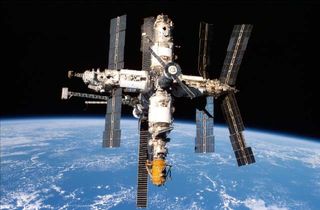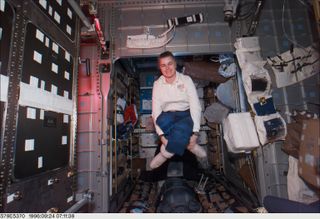Mir Space Station: Testing Long-Term Stays in Space
Mir was a space station that operated for more than 15 years in low Earth orbit. The design was conceived under the Soviet Union, and the station continued work under Russia after the union fell apart in the early 1990s.
The space station served as an important precursor to today's International Space Station. Aboard Mir, crews dealt for the first time with long-duration stays in space of more than 400 days. Health effects and psychological situations were observed and documented.

In later years, NASA used Mir as a testbed for international co-operation. The agency was eager to move forward with ISS, but felt that it required experience working with Russia before continuing. As such, NASA signed an agreement to send its astronauts aboard Mir.
Results from the program were mixed, with some American astronauts comparing about feeling isolated and undersupported when training overseas. Worse, by the time NASA astronauts arrived, Mir was nearing the end of its operational lifetime and experienced frequent power failures and a near-fatal fire.
Astronauts generally, however, got a lot of microgravity research done during the program. Also, the experience aboard Mir gave NASA and the Russian Federal Space Agency (Roscosmos) an education on how to best work together for ISS.
Extending long-term duration experience
According to Enyclopedia Astronautica, Mir was intended as a successor project to the Soviet Union's Salyut series of space stations. While the United States was focused on the moon program in the 1960s and developing the shuttle in the 1970s, Russia went in another direction after the space race.
The country worked on developing expertise in long-duration spaceflight, and felt that a larger space station would allow for more research in that area. Mir was originally authorized in a February 1976, then evolved by 1978 to a station with several ports for crewed Soyuz spacecraft and cargo Progress spaceships.
NPO Energia began work in earnest on the station in 1979, reportedly subcontracting the responsibilities to KB Salyut because Energia was preoccupied with the Salyut, Soyuz, and Progress programs, among others. Work stalled somewhat as Russia developed a Buran space shuttle, but according to the encyclopedia, in 1984 the Soviet Union made it a priority to orbit the station in two years to coincide with the 27th Communist Party Congress in spring 1986.
It took some planning adjustments, but the first module of Mir launched successfully on Feb. 20, 1986. The next step would be bringing it alive for cosmonauts to occupy it.
"The decision was taken to launch Soyuz T-15 on a unique dual station mission," the encyclopedia stated in an article about Mir's construction.
"The Soyuz would first dock with Salyut 7, which was dead in space, and completely repair the station. They then would fly in their Soyuz to Mir, and put it into initial operation. This spectacular mission marked a new maturity in the Soviet space program."
Construction and dissolution
Mir was a modular space station, meaning that there were different parts that were shipped up and put together to form the greater whole. The first module that launched was the Mir base block (or core module).
During the next decade, the Soviets launched several other modules. But political change was brewing amid the construction. The Soviet Union dissolved when one Soviet cosmonaut, Sergei Krikalev, was in space between 1991 and 1992. He is sometimes dubbed "the last Soviet citizen" because of this.
After construction was finished, Mir had a collection of facilities. At 43 feet (13.1 meters) long, the "core" module of the station was the main area where the cosmonauts and astronauts did their work. It also housed the main computer and vital space station parts, such as communications.
In addition to solar arrays and a docking port, the station had several facilities for orbital science. These included, but were not limited to, two Kvant modules (that did astronomy and other science research), Kristall (which had a facility for microgravity manufacturing) and Spektr (focused on Earth work).
Mir is most famous for hosting long-duration missions during its early years in space. For this reason, the Soviets and Russians dominate the list of the 10 longest spaceflights on record. Topping the list is Valeri Polyakov, who spent nearly 438 days aboard Mir and landed on March 22, 1995.

Shuttle-Mir program
In 1993, NASA and Russia made a pact to bring space shuttles to Mir. This would benefit the respective programs in a couple of ways. It would give NASA astronauts, then confined to shuttle flights, some valuable long-term flight experience. And it would provide Russia with some badly needed cash as the young country struggled to keep its expensive spaceflight program afloat.
The program ran between 1994 and 1998, with several NASA astronauts spending months aboard the orbiting facility. They trained in Russia, working to learn the language and a new space program all at the same time. Some of the astronauts thrived in the new environment, while others struggled. (More details are provided in the book "Dragonfly," which covers the history of the program.)
Meanwhile, mechanical problems aboard Mir mounted, particularly in 1996-97. Astronaut Jerry Linenger's mission in particular was marred by issues ranging from a fire that broke out on Mir, a resupply ship that nearly hit the station, and several failures of onboard systems.
The next shuttle astronaut on Mir, Michael Foale, was among a crew that experienced a collision with a resupply ship. Criticism of the program reached an apex during Linenger's and Foale's stays in space, with some arguing it was unsafe to keep the astronauts on board. Congress launched an inquiry. However, NASA deemed the situation safe enough and the program continued until 1998.
The International Space Station presented a new platform for Russia and the United States to work together. However, it also proved to be a drain on Russia's finances. Private schemes were contemplated to keep Mir working, but they fell through. Russia thus decided to deorbit Mir to preserve money for ISS.
Mir broke up in Earth's atmosphere on March 23, 2001, with some large fragments falling into the South Pacific Ocean – well away from inhabited areas. The station had a tumultuous history, but the lessons learned on board Mir are still used by NASA, Russia and their spacefaring partners today.
— Elizabeth Howell, SPACE.com Contributor
Join our Space Forums to keep talking space on the latest missions, night sky and more! And if you have a news tip, correction or comment, let us know at: community@space.com.
Get the Space.com Newsletter
Breaking space news, the latest updates on rocket launches, skywatching events and more!

Elizabeth Howell (she/her), Ph.D., is a staff writer in the spaceflight channel since 2022 specializing in Canadian space news. She was contributing writer for Space.com for 10 years before joining full-time. Elizabeth's reporting includes multiple exclusives with the White House, speaking several times with the International Space Station, witnessing five human spaceflight launches on two continents, flying parabolic, working inside a spacesuit, and participating in a simulated Mars mission. Her latest book, "Why Am I Taller?" (ECW Press, 2022) is co-written with astronaut Dave Williams.